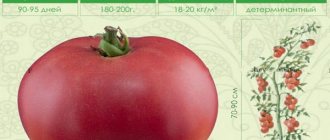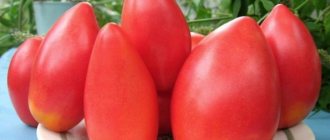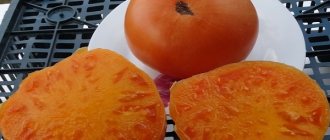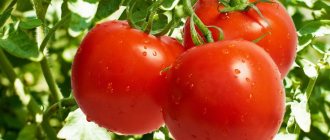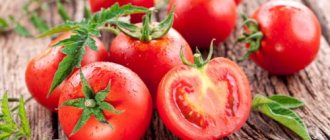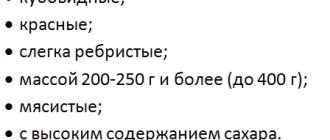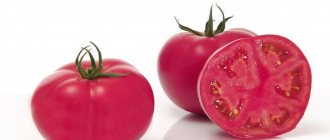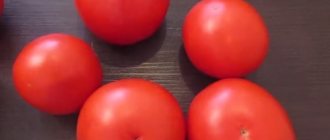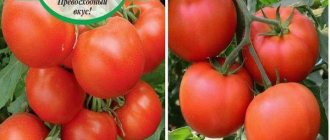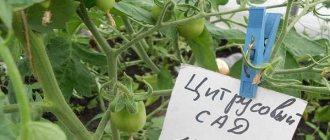Summer residents like intuition for its resistance to weather conditions, exceptionally high yields and immunity to major diseases. Being a first generation hybrid, Tomato is unpretentious and does not require special attention.
| Height | Landing location | Ripening time | Fruit color | Fruit size | Origin | Fruit shape |
| Tall | Greenhouse | Mid-early | Reds | Average | Hybrid | Round |
Tomato Intuition F1: description
The features of this tomato are high marketability, a beautiful round and even shape of the fruit, excellent yield, as well as excellent shelf life over a long shelf life.
Tomato Intuition F1 is a medium-ripening variety with unlimited shoot growth, the so-called indeterminate vegetative type. Reaching a height of 2 meters, the bush, covered with healthy matte green foliage, looks quite impressive and is grown mainly in greenhouses, without requiring complex care. Due to its hybrid origin, the tomato has a very high resistance to various tomato scourges, such as fusarium blight, cladosporiosis, tobacco mosaic virus and other problems.
Fruit ripening begins 100-115 days after germination of seedlings. Simple double-sided inflorescences are laid like this: the first is above the ninth leaf, the rest are every three subsequent ones. The inflorescence consists of 6-8 fruits, attached to a short and very strong axis, capable of supporting the weight of a ripening cluster. A special feature of the tomato is its very impressive yield - from 25 to 32 kg of bright red, smooth fruits with an ideal round shape can be collected per square meter. They are worthy of a separate discussion: like many hybrid varieties, Intuition F1 produces tomatoes on the bunch that are almost identical in weight and ripening time.
The weight of tomatoes varies from 90 to 110 grams. Smooth, even, without visible ribbing, the fruit has 3-4 seed chambers, is famous for its good taste, and is excellently stored and transported.
Fruit characteristics
- The shape is perfectly round, without ribbing.
- Dimensions - about 7 cm in diameter, weight - from 100 g.
- The skin is smooth, dense, thin, shiny.
- The color of unripe fruits is pale green without dark spots, ripe fruits are deep red.
- The consistency of the pulp is fleshy, tender, dense.
- The seeds are located evenly in 3 - 4 chambers.
- The amount of dry matter is average, about 4.5%.
- They have a beautiful presentation.
You can compare the weight of the fruits of a variety with others using the table:
| Variety name | Fruit weight |
| Intuition | 100g |
| Miracle Lazy | 60-65 grams |
| Sanka | 80-150 grams |
| Lyana Pink | 80-100 grams |
| Shchelkovsky Early | 40-60 grams |
| Labrador | 80-150 grams |
| Severenok F1 | 100-150 grams |
| Bullfinch | 130-150 grams |
| Room surprise | 25 grams |
| F1 debut | 180-250 grams |
| Alenka | 200-250 grams |
The taste is slightly sour. The flesh is dense but pleasant. “Intuition” is used in any form, the most successful use is fresh and canned. The density of the fruit allows the preservation of whole fruits; they retain their shape well.
Suitable for hot processing and freezing. Tomatoes do not change the content of nutrients when treated with heat or cold. It is possible to produce tomato paste, sauces, ketchups and juice.
Long-term storage is possible due to the good density of the fruit. When storing tomato crops, use dark, dry places without sudden temperature changes, preferably room temperature. They handle transportation well even over long distances.
Growing seedlings: soil preparation
Considering that the vast majority of domestic regions cannot boast of a warm climate, and the tomato is a southern crop that produces a full harvest exclusively in comfortable conditions, growing tomatoes in greenhouse conditions is optimal. And you should start by sowing seeds for seedlings.
Recently, gardeners have replaced seedling boxes with disposable containers, which undoubtedly reduces the risk of infection of seedlings, the possibility of which remains with repeated use. But new containers must also be disinfected before laying the soil. The most acceptable height for seedling containers is 6-8 cm.
Soil for seedlings can be purchased at a gardening store or prepared independently by combining humus and peat in equal parts with turf soil. Add 1 kg of coarse river sand, 100 grams of wood ash and 30 grams of superphosphate to a bucket of the prepared mixture. There is no need to add fertilizers to prepared soils; they contain a full range of essential nutrients.
Tomato Intuition F1 is sown for seedlings in February-March. It is impossible to indicate specific dates for sowing due to the enormous extent of the country; moreover, in each region, gardeners use their own accumulated experience, taking into account local conditions. Soil is poured into the prepared seedling containers, slightly compacting it, since the planted seeds should not end up in an air pocket - this will negate all efforts and they will not be able to germinate.
Advantages and disadvantages, differences from other varieties
The Intuition tomato has a lot of undeniable advantages that confirm the need to plant this crop in your summer cottage. Among them:
- high yield rates;
- incomparable taste and attractive shape of vegetables;
- unlike other varieties, the fruits are the same size;
- no tendency to crack;
- 100% seed germination;
- uniform fruiting throughout the growing season;
- resistance to common crop diseases.
To properly breed the Intuition tomato, it is important to take into account the disadvantages of the variety, such as:
- excessive height of the bushes - therefore there is a need to build 3-meter structures to support the stems;
- the taste of the fruit, according to many gardeners, is inferior to salad tomatoes;
- inability to obtain your own seeds.
Seed preparation
If you purchased seeds that have already undergone pre-sowing preparation, which is indicated on the packaging, then no additional work needs to be done with them. And ordinary seeds will have to be treated and stimulated for further high-quality growth. Although the tomato Intuition F1 (“Gavrish”) is very resistant to various infections, it requires pre-sowing treatment, like many other varieties and hybrids.
The “Fitosporin-M” product will help to disinfect the seeds, in a solution in which they are immersed for 20-25 minutes. And modern biogrowth stimulants, such as Epin or Zircon, will protect the seeds and awaken them. They activate the formation of shoots, support the immune system and neutralize subsequent stress conditions of the plant during sudden cold snaps, drying out and other problems. All solutions should be prepared in accordance with the instructions included with the preparations. The soaking time of seeds in solutions is also adjusted based on the information provided in the instructions.
Planting seedlings
The seeds prepared in this way are placed in the grooves, deepened by 1-1.5 cm, watered with a warm, weak solution of sodium humate and sealed. Seedling containers are placed in a bright place with a room temperature of at least 22-24 °C. To create the most comfortable conditions for the germination of seedlings, the containers are covered with glass or film on top. The microclimate that occurs in containers with seedlings will protect the sprouts and allow them to quickly turn into strong seedlings.
With the correct algorithm of actions and high-quality seeds, germination occurs on the third to fifth day. As soon as this happens, the cover is removed from the box. Now it is important not to flood the plants. This is a mistake that novice gardeners often make, and this can lead to the death of seedlings, since the fungus that causes blackleg and is always found in the soil uses excess moisture. Such infections destroy even very strong seedlings. The room temperature should be maintained at the same level that was maintained during seed germination.
The next stage of cultivation is the picking of strong seedlings, characterized by simultaneous germination and excellent survival, for which the Intuition F1 tomato is famous. Reviews from gardeners who know this hybrid are unanimous: the tomato germinates quickly and develops well.
How to grow seedlings yourself
The key to a bountiful summer harvest is properly grown seedlings. Next, you will learn all the details of this process - from choosing the optimal sowing date to preparing young shoots for planting in a permanent place.
Sowing time
The optimal time for sowing seeds is considered to be the end of February - mid-March. In this case, you will reap the first harvest in early July.
Important! You can choose the correct date for planting seeds for seedlings as follows: subtract 55-60 days from the date when you plan to plant the seedlings in a permanent place. This will be the perfect date
Container and soil
Wooden containers are well suited for growing tomato seedlings. The soil in which the seeds will germinate also needs preliminary preparation. You can prepare a nutritious soil mixture yourself - mix soil, peat, humus and wood ash in a container. You can add a small amount of superphosphate. This soil mixture will provide the root system of young shoots with nutrients that are so necessary at the initial stage of tomato growth. If you don’t like making your own preparations, you can purchase ready-made soil for growing seedlings at any agricultural store.
Seed preparation
It is advisable to disinfect the seeds before planting. This will increase the plant's resistance to diseases. To do this, the seeds are soaked in a weak solution of potassium permanganate (soaking time - 2 hours). Instead of potassium permanganate, you can use Fitosporin. Some gardeners additionally treat the seeds with various plant growth stimulants. After the preparatory procedures, the seeds are washed with warm water. Now they are ready to plant.
Did you know? Among more than 10 thousand varieties of tomatoes, the smallest tomatoes grow 2 cm in length, and the largest reach a weight of 1.5 kg.
Sowing seeds: pattern and depth
Treated seeds are planted in containers to a depth of 3-5 cm
It is important to maintain a distance between sowings - at least 2 cm. Having deepened the seeds, press the soil and water it abundantly with warm water. The top of the future tomatoes is covered with polyethylene.
The top of the future tomatoes is covered with polyethylene.
Conditions for germination
For seedlings to appear, it is important to maintain the temperature at 25°C. The moist environment under the polyethylene helps the seeds to germinate
Seedling care
So, a start has been made, and the first shoots of “Intuition” have appeared in your containers. Further care will be easy. Until the long-awaited sprouts appear, daily watering is enough. And after the emergence of seedlings, it is enough to water once every 5-6 days. When watering, use settled water at room temperature. After you find 2 strong leaves on the sprout, the plants can be picked and planted in separate containers. If you decide to feed the seedlings, then you should start fertilizing no earlier than 2 weeks after picking. Fertilize the seedlings with the same fertilizer as the tomatoes themselves.
Hardening of seedlings
An important stage in growing seedlings is their hardening. This procedure is carried out as follows: plants in containers are taken outside or, for example, a window is opened if you are growing seedlings on a windowsill. It is advisable to carry out hardening for 2 weeks, until the plants reach 55 days of age. After 55 days, the seedlings are planted in a permanent place - in a greenhouse or in open ground.
Picking up tomato seedlings
This operation is carried out when three or four true leaves grow on the seedlings. This is an indicator of a sufficiently strong sprout with a properly forming root system. For the process to proceed normally, each seedling should be placed in a separate pot, since developing roots require more space. The techniques used when transplanting seedlings are simple, but everything must be done carefully, without damaging the fragile roots.
Each plant is carefully removed from the container with seedlings, preferably together with a lump of earth, and transplanted into pots of larger capacity. Their diameter should not exceed 8-10 cm, and a height of 10-12 cm is considered optimal. This volume is enough for the seedling to get stronger, but not to outgrow it until it is planted in the greenhouse. Practice has shown that the tomato Intuition F1 (reviews from gardeners confirm) tolerates diving well.
Seedlings should not be kept in separate containers for more than 50-55 days; the height of well-developed seedlings by that time reaches 30-35 cm. During their stay at home, care must be taken that they do not stretch out. This is facilitated by optimal temperature and light conditions. It is necessary to turn the containers with seedlings towards the window every day if the seedlings lack light. 10 days before the planned planting of seedlings in a greenhouse, it is necessary to harden the plants: take them out onto the balcony or open the windows at night.
Care after transplant
The main care activities are:
- weeding;
- watering;
- loosening;
- garter.
Gartering of bushes is required for the Intuition variety.
It is not necessary to water the seedlings immediately after transplanting so that the seedlings take root well. The first watering is recommended after 10 days. It is necessary to water the seedlings with warm water (20-25 degrees) to avoid various diseases. Before the flowering period, this variety should be watered once every five days.
Watering rate is 1.5 liters per bush. During the flowering period, water consumption per bush is from 4 to 5 liters.
The weeding and loosening procedure is performed every 14 days
This must be done extremely carefully so as not to damage the root system of the seedlings.
The formation of a bush is carried out with the aim of removing side shoots so that the bush gives more strength to the fruits. Pruning should be done once every 14 days. At the end of summer, the top of the bush is cut off so that it no longer grows upward. Bushes growing in a greenhouse should be trimmed after the seventh cluster, and bushes growing in a garden bed after the fifth.
Since Intuition is a tall variety, a garter is a prerequisite for care. It can be carried out within two weeks after transplantation. The height of the support must be at least three meters. You need to tie up the bushes carefully so as not to damage the stem. For this purpose, it is best to use nylon thread.
Two weeks after planting, the seedlings need to be fertilized. To do this, add 500 grams to 10 liters of water. cow dung and 20 gr. nitrophoska. Apply 1 liter of fertilizing per bush, and repeat fertilizing after 14 days.
Preparing the greenhouse
To ensure further comfortable growth of young plants, it is necessary to carry out high-quality treatment of both the soil in the greenhouse and the frame part of the greenhouse itself. Different regions have different timings for planting seedlings in a greenhouse, but usually they vary from the beginning to the end of May. Therefore, if the covering of the greenhouse is film, and the spring turned out to be cold, then you may have to put two layers of film or use a denser (reinforced) one. Using a double film coating is more effective, since the air cushion that inevitably appears between the layers will not only increase the temperature in the greenhouse, but will also significantly increase the performance capabilities of the inner layer.
There should be vents on each side of the greenhouse for good ventilation. To avoid infection of seedlings, it is recommended to remove the top layer of last year’s soil (7-10 cm). The remaining soil is treated with a solution of copper sulfate in a proportion of 30 grams per bucket of water. All parts of the greenhouse frame, wooden or metal, must be subjected to the same disinfection. It is necessary to replenish soil loss with humus.
Experienced gardeners recommend changing vegetable plantings in greenhouses annually. But if this is not possible, then the presented method of removing the old layer of soil and replacing it with humus is quite acceptable and will not reduce the planned yield. Tomatoes, in particular the Intuition F1 tomato, the cultivation of which does not involve any particular difficulties, extract maximum nutrients from the soil, and replacing the top layer with the addition of a full range of necessary microelements is a good option for obtaining a high yield.
Soil treatment is carried out at least 10 days before planting seedlings. The soil must be loosened, emerging weeds and fragments of old roots must be removed. Humus is added in an amount of 8-10 kg per square meter; a glass of wood ash (for the same area) will not harm. The optimal types of soil for growing tomatoes in a greenhouse are breathable loams or sandstones.
Features of planting seedlings
Intuition F1 is a tomato whose reviews from gardeners are very impressive, but before planting young plants it is necessary to check that several prerequisites are met:
- Tomatoes are planted in a greenhouse on a cloudy day or in the evening;
- the soil is moistened in advance; a few grains of manganese can be added to the water for irrigation;
- before planting, it is necessary to carefully examine the seedling, remove cotyledons, first, yellowed or diseased leaves;
- the soil in the greenhouse must be warmed up; tomatoes cannot be planted in cold soil, since the roots of the seedlings will simply rot, and prolonged cold will intensify the process, and the plant, at best, will take a long time to take root, and at worst, will die.
The soil temperature when planting seedlings should be no lower than 12-15 °C. You can warm up the soil artificially by covering the ground with black plastic film. By the way, it will play the role of mulch, prevent the growth of weeds, and maintain optimal temperature and water exchange, which will significantly reduce the worries of gardeners.
Tomato Intuition F1 (reviews from experienced gardeners indicate this) does not like deep deepening when planting, as this will stop its growth - sprinkled with soil, the stem is activated to form new roots to the detriment of the development of the stem. There is a danger of overdoing it with the application of nitrogen fertilizers, the excess of which will cause vigorous growth of foliage and the absence of ovaries and fruits. Often, novice gardeners fertilize the planting holes with fresh manure, urea or chicken droppings. This is strictly forbidden.
Intuition F1: aggro. Feedback on landing
Growing tomatoes in a greenhouse is easy if you know all the features of agricultural technology. Typically, beds in a greenhouse three meters wide are divided into shares. Arrange 2 ridges with a passage between them of 50-60 cm. The agro product is a tall and strong plant. Therefore, the distance between bushes when planting should not be less than 50 cm.
The minimum intervals between the rows of this tomato should also not be less than 60 cm. Bushes should be planted in rows in a checkerboard pattern to ensure the gardener has free access to each plant. Typically, in a greenhouse 6 meters long and 3 meters wide, 46-48 tomato bushes are planted in two beds with two rows on each. And this quantity is the maximum. With this planting scheme, you can optimally use the space in the greenhouse and prevent thickening, which negatively affects the development of any crop, causing a lack of light, difficult ventilation, and, as a result, the spread of diseases. The same requirements are put forward by the tomato Intuition F1. Planting and caring for it is not a difficult task, but you need to adhere to certain rules.
Tomatoes in a greenhouse
Proper care of plants in a greenhouse is the key to a future harvest; it begins as soon as the seedlings are planted in the greenhouse. Let us list the main stages of caring for a plant such as the Intuition F1 tomato. Reviews from gardeners who have been growing this hybrid for years are clear in defining these stages:
- In the first days after planting, there is no need to water the plants. Usually they wait 10 days. During this time, the tomatoes will take root, then watering is carried out.
- The water temperature for irrigation should not be lower than 20-22 °C.
- Before flowering, Intuition F1 is watered once every 4-5 days. The water consumption rate per plant is 1.5 liters.
- During the flowering period, watering is increased to 4-5 liters per bush.
- The bushes should be watered at the root; it is better to do this in the morning, since evening watering promotes the formation of condensation, which gets from the film covering onto the tomatoes.
- Maintain optimal temperature and humidity. The most comfortable temperature is 25-28 °C during the day and 18-20 °C at night.
- Don’t be afraid to ventilate your plantings - tomatoes are indifferent to drafts. And ventilation 2 hours after watering is a prerequisite to stimulate fruit set.
Features of cultivation and storage
Seedlings are grown with one pick until the age of 55 days. A week before planting, seedlings begin to be taken outside to harden off. They are planted in the greenhouse when the first corollas form. They must be replanted with a clod of earth.
The fruits of Intuition are perfectly stored and transported. The hybrid was specially created for the sale of fresh tomatoes. Tomatoes can be transported in boxes stacked in several layers. When harvested at technical ripeness, they can lie in a room with a temperature of +10 degrees for more than a month.
Garter and stepson
Since Intuition F1 is a tomato (reviews from gardeners confirm this) with unlimited stem growth, its garter is mandatory. It is carried out on the 3-7th day after planting the seedlings. It is necessary to help the plant withstand the weight of the filling fruits. The material for the garter should be chosen so that it will not injure the tomato stem. Various gartering methods are used, including trellises - linear or frame.
Another necessary procedure is pinching, which involves removing shoots growing from the axils of the leaves. This must be done, since they form a tomato into 1 or 2 stems, carefully monitoring the formation of new shoots and removing them in a timely manner. Their formation and uncontrolled rapid growth will significantly reduce fruit formation, lead to thickening and slow down ripening. It should be noted that not all varieties and hybrids are subject to strong formation of these side shoots; in many tomatoes it is very moderate. These varieties include the tomato Intuition F1. Agro, whose reviews of hybrids emphasize the short growth of stepchildren, offers consumers a whole range of similar tomatoes. Stepchildren should be removed carefully; you can break them out or cut them out. It is better to carry out such work in the morning.
Rules for the variety
7 days after the seedlings take root, they need to be tied to a support, since a tall bush will not benefit from being overloaded with fruits in the future. While the stem is growing, it must continue to be tied up.
The formation of a bush occurs in 1-2 stems. Excess shoots are cut off. Leaves and shoots are removed before the first flower. In the future, you should remove the leaves under the tassels that have become knotted.
Fertilizers can be herbal infusion, mullein infusion and wood ash. The ash can be added in dry form and the leaves can be sprayed with the solution. Or make an ash hood.
Feeding
Like any tall plant, tomatoes require periodic feeding. The tomato Intuition F1 is no exception. Planting, survival of the bush and its subsequent development depend on the correct and regular application of nutrients needed by the plant.
The first feeding from the moment of planting is carried out 10-15 days later: 30 grams of nitrophoska and 0.5 liters of liquid mullein are diluted in 10 liters of water. The feeding rate per bush is 1 liter. After 10 days, the tomatoes are fertilized a second time: 30 grams of potassium sulfate and Fertility fertilizer are taken per 10 liters of warm water. The same feeding will need to be repeated again in two weeks.
Following these tips, it is not difficult to grow an Intuition F1 tomato in a greenhouse. The reviews and photos presented in the article will help clarify the details of growing this excellent crop.
Protection from diseases and pests
To prevent invasions of parasites and the occurrence of diseases, it is recommended to subject the tomato variety Intuition to preventive measures:
- Use high quality seeds for sowing, previously disinfected. Seed material should be purchased from trusted sellers.
- Maintain crop rotation. Do not place tomatoes next to potatoes.
- During the growing season, carry out several preventive sprayings of bushes against pests and diseases. Insecticides used against harmful insects are Aktellik, Aktara. Fungal diseases are treated with fungicides - Topaz, Quadris.
- Diseased bushes need to be pulled out, taken outside the site, and burned.
Tomato growing technology Intuition is not complicated and is within the power of every vegetable grower. You just need to follow the recommendations and the result will be worthy.
